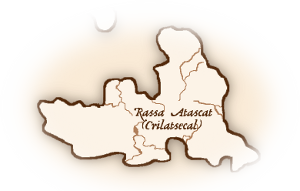
Crilatse Grammar
Contents
Nouns (cuacal)
Nouns add suffixes to show pluralization or possession (genitive case):
| Plural | Genitive | Genitive Plural | |
|---|---|---|---|
| arussca "man" | arusscacal "men" | arusscascat "man's" | arusscacalscat "men's" |
When showing possession, the possessor is placed second, e.g. su tefcacal arusscascat "the man's eyes."
If a feminine form is needed for a noun, the suffix -st is added, e.g. arusscast "woman."
Back to topVerbs (alaracal)
Conjugation
There are four patterns of verb conjugation, based on the infinitive ending: -al, -el, -il, and -cul. To conjugate a verb, remove the ending (-al, -el, -il, or -cul) and add the appropriate inflection:
Present Tense
| Person | -al Verbs | -el Verbs | -il Verbs | -cul Verbs |
|---|---|---|---|---|
| I | -at | -et | -it | -cuat |
| you | -atu | -etu | -itu | -cuatu |
| he/she/it | -as | -es | -is | -cuas |
| we | -atac | -etac | -itec | -cuatac |
| you (plural) | -atuc | -etuc | -ituc | -cuatuc |
| they | -asac | -esac | -isec | -cuasac |
Past Tense
| Person | -al Verbs | -el Verbs | -il Verbs | -cul Verbs |
|---|---|---|---|---|
| I | -ae | -ae | -ae | -uae |
| you | -aet | -eat | -ait | -uet |
| he/she/it | -ate | -ete | -ite | -ute |
| we | -atae | -etae | -itae | -utae |
| you (plural) | -aet | -eat | -ite | -uet |
| they | -asae | -esae | -isae | -usae |
The verb cul
The verb cul ("to be") is irregular and is conjugated as follows:
| Person | Present Tense | Past Tense> |
|---|---|---|
| I | cuat | cuae |
| you | catu | cuet |
| he/she/it | catas | cuaet |
| we | cuatac | cutae |
| you (plural) | cuatuc | cuet |
| they | cuasac | cusae |
Negation
Negation is accomplished by adding the prefix up- to a verb. For example, tirstat "I see" becomes uptirstat "I don't see".
Noun Formation from Verbs
Verbs replace the infinitive suffix with the suffix -ac to become nouns, e.g. tirstac "sight" from tirstal "to see".
To form an agent noun from a verb, add the suffix -atse to the infinitive, e.g. ssiculatse "walker" from ssicul "to walk" or crilatse "follower" from cril "to follow".
Back to top
Pronouns
| Nominative/Accusative | Genitive | |
|---|---|---|
| I | at | ascat |
| you | atu | atuscat |
| he | as | escat |
| she | asu | uscat |
| it | ase | iscat |
| we | atac | atascat |
| you (plural) | atuc | atuscat |
| they | asac | asascat |
Sentence Structure
Sentences follow a subject-object-verb order. Adjectives and adverbs are placed immediately (or as close as possible after) the word they modify.
Examples:
- Arussca cuat. ("I am a man.")
- Su arusscast tefcacal huraca arses. ("The woman has blue eyes.")
- Fulhassacal tasus te ssura uparsetuc ("We do not have yellow and green feet.")